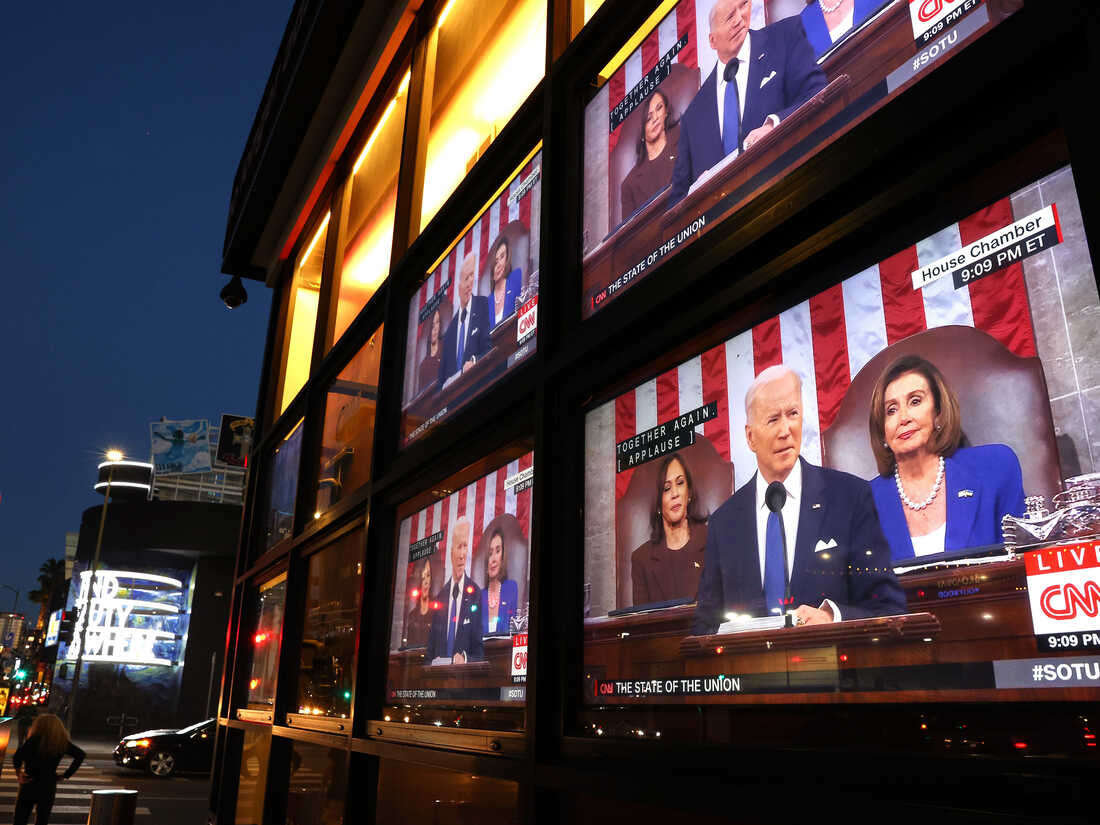A speechwriter’s guide to watching tonight’s State of the Union address

Televisions broadcast President Joe Biden as he delivers his State of the Union address last year.
Mario Tama/Getty Images
hide caption
toggle caption
Mario Tama/Getty Images
Televisions broadcast President Joe Biden as he delivers his State of the Union address last year.
Mario Tama/Getty Images
Welcome to a new NPR series where we spotlight the people and things making headlines — and the stories behind them.
On its surface, the State of the Union address serves as a check-in from the president. But the annual orchestration includes the efforts of many, including speechwriters, who aim to communicate the priorities of the Oval Office.
And if they’re lucky, they might land a good State of the Union Moment ™
Who are they?
- Cody Keenan is a political advisor and former chief speechwriter for Barack Obama.
- Michael Ricci is a fellow at Georgetown University’s Institute of Politics and Public Service and has written speeches for Republicans like John Boehner and Paul Ryan.
What’s the big deal?
- If you’re into politics, you’ll know that the State of the Union address is much more than just a speech; it’s a look into how the sitting president wants to posture themselves, and more importantly, what we might be seeing in the leadup to the 2024 election.
- To those watching on the Hill, every little detail matters (think Twitter stan culture, but applied to politics)
The talking points. Ricci and Keenan talk us through four things to consider from the State of the Union.
- The role of the speechwriter “This is [difficult] for White House speechwriters, because you have every cabinet agency, every interest group, everybody’s pushing on you to get their policy idea in the speech. And it’s exhausting. And it’s the speechwriter’s job to prevent it from becoming a Christmas tree, putting something in the speech just because somebody will be mad that you don’t, it’s not good writing. So it’s just this kind of neverending battle.” – Cody Keenan“I also had to struggle with different stakeholders look[ing] for different language, on how much the president puts his shoulder to the wheel rhetorically. So committee chairs will [say], ‘Did the president make a vague call to action? Did he specifically say pass this bill or hammer an issue home?’ Committee chairs, stakeholders, people watching, obsess about that stuff. And these are all choices that the White House speechwriters have to make.” – Michael Ricci
-
Who Biden is actually speaking to“As he tries to lay out the contrast between the parties, he’s definitely going to be mentioning policy issues that probably play well in the suburbs. He’s going to talk about capping the cost of insulin and things like that.
There’s only so much they can do to actually bring in the Republicans in the room. So a lot of it is about going over the heads of the Republicans in the chamber, and trying to reach commonsense conservative voters with rhetoric that appeals to people in the middle. – Michael Ricci -
The Speaker’s response
“The White House is thinking about all the big different issues on the Hill. They’re mostly thinking about what the members of Congress are obsessed with. And usually that’s 2 to 3 things at a time.
You prepare on 12 to 15 issues. You prepare a rapid response. You try to get all your ducks in a row, but in the end, you only have so much oxygen against the president. So from my experience, I can tell you that usually it comes down to, you plan for everything, but usually you have to boil it down to two or three things you’re going to hit hard on in your response.”
– Michael Ricci -
How much rides on making a “big moment”
“You can create these big moments. And, you know, President Obama was joking on game day that the beginning and the ending of the speech were in great shape. And we just kind of said the middle is fine. And that’s the part where you have this laundry list of proposals. But the opening and the ending are really what kind of lend themselves to emotional moments that people will remember. And I want to give the Biden speechwriters some cover here. There is no clever turn of phrase or story that’s going to necessarily guarantee action or secure unity or bring people along. I mean, that’s always kind of an ongoing thing. No speech is going to change everybody’s minds, but those are the moments people remember.” – Cody Keenan
So, what now?
- While Biden’s speech may not be able to shift his approval ratings dramatically, he’ll be able to give voters an idea of what his priorities are ahead of his expected bid for reelection in 2024.
Learn more
- Ready to tune in? Here’s how to watch and listen to President Biden’s State of the Union speech
- Learn about how theBlack caucus sees the State of the Union as an important chance to push for police reform among current events.
- And for a breakdown on what to look for, here are the key issues to watch for in Biden’s State of the Union
